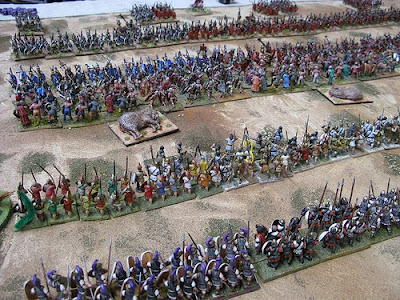We replayed Zama at the Carronade show in Falkirk today. This time, it was a draw with both armies reaching their break point in the same turn, Carthage first. Photos courtesy of Michael:
All three show the point of contact between the first waves of infantry in both armies. I really like the first one, the close-up, which shows some of Simon the Big Red Bat's elephant casualty figures. The second photo is a full table shot from the Roman right rear; the third is from the Carthaginian left rear. In all three you should be able to see the second and third lines of Carthaginians, and the Principes with Triarii in column in reserve on the Roman side.
After the Battle Day game on the sand table, which was a comprehensive Roman victory, we tweaked the rules somewhat. The Romans were allowed a pilum volley once per unit; to compensate, the Ligurians and Celtiberians could only try to gain impetus once. We also raised the quality of the Carthaginian citizens to Veteran Medium Infantry. The idea was to try to get the central grinding match as close as possible.
In the event, the game worked really well. The elephants took a nasty volley from the Velites before the latter were negated by the Carthaginian skirmishers. This meant that when the elephants contacted the Hastati, the pachyderms were easily destroyed with little loss to Rome. The central infantry grind then began, with only a couple of Ligurian units getting in a full charge. When the dust cleared from the initial contact, the Carthaginian expendables had been expended, but nearly half of the Hastati were still there, albeit damaged. The Citizens went in next and finished off the Hastati at horrendous cost to themselves. They in turn were wiped out by the Principes, inflicting enough damage to give Hannibal's veterans a good chance.
In the meantime, both sides were extremely unwilling to commit their heavy cavalry. When the clash did come, the Carthaginians were comprehensively wiped out, unlike the previous game. On the other flank, Masinissa recklessly charged in against Tychaeus and had a bad time, spending the rest of the game skirmishing ineffectually.
The overall crisis came right across the front. On the Roman left, one unit of Hannibal's troopers had to peel off to stop the cavalry flanking the entire Carthaginian army. This gave the Romans superiority in this part of the line, which they exploited ruthlessly, as is their wont. The Bruttians in the centre of the third line of Hannibal's army crunched through the Principes and into the Triarii. And on the Roman right some of Tychaeus' horse managed to help out against the rightmost unit of Triarii.
The Carthaginian army reached its break point first, but as we played out the turn to full conclusion, so did the Romans.
For photos of the other games, see http://www.flickr.com/photos/46755253@N00/sets/72157624018418900/

















.jpg)






















.jpg)







.jpeg)













.jpg)





































































































